Bitcoin’s harmonic formations indicate evolving market behavior, challenging previous cycle patterns
- Bitget analysts identify a Bearish Bat pattern on Bitcoin's 1-hour chart, projecting a 3.68–4.51% rebound to $109,512–$110,382 as the pattern completes its final CD leg. - The pattern's validity depends on breaching the PRZ at $110,000, which could trigger short-term buying momentum amid reduced volatility from institutional adoption and ETF approvals. - Bitcoin's 26% recent pullback contrasts with historical 77–84% declines, reflecting maturing market dynamics driven by long-term holder accumulation and

Technical signals for Bitcoin (BTC) currently point to a possible short-term bounce, as a distinct harmonic pattern is emerging on its 1-hour chart. Bitget analysts have spotted a Bearish Bat formation, a chart pattern that often highlights potential reversal areas (PRZ) at important Fibonacci retracement points. The pattern is now completing its final CD segment, with anticipated price targets ranging from $109,512 (0.886 Fib) to $110,382 (1.0 Fib) title2 [ 2 ]. This indicates
The Bearish Bat pattern is generally interpreted as bullish until it completes, and its appearance coincides with Bitcoin’s rebound from the $102,000 support level after escalated tensions between Israel and Iran. Whether the pattern holds will depend on Bitcoin’s ability to break through the PRZ, which could spark a surge of short-term buying from both traders and institutions. Should
Bitcoin’s price trends are being shaped by shifting market forces. The traditional four-year cycle, which has historically been linked to halving events, appears to be changing due to factors like the launch of U.S. Bitcoin ETFs, increased institutional involvement, and clearer regulations. Matthew Hougan, Bitwise Asset Management’s chief investment officer, pointed out that the 2024 halving lined up with a record high of $73,000 in March 2024—months ahead of the event—unlike previous cycles where peaks came 12–18 months after the halving. This change highlights stronger institutional demand and reduced price swings, as long-term holders and steady inflows help prevent sharp corrections title1 [ 1 ].
Recent downward corrections have also been less drastic than in past cycles. For example, the largest drop in the current cycle has been about 26%, much less severe than the 77–84% declines seen in 2017 and 2021. Ryan Chow of
For market participants, the harmonic pattern presents a strategic chance to benefit from Bitcoin’s short-term momentum. Completion of the pattern at the PRZ could coincide with a broader rally, especially if macroeconomic factors remain supportive. However, the effectiveness of this setup depends on Bitcoin’s ability to sustain liquidity and avoid renewed volatility from external shocks. Experts advise keeping an eye on key levels, such as the $105,000 support and $110,000 resistance, as well as monitoring the global geopolitical environment for possible disruptions title2 [ 2 ].
The significance of this technical formation goes beyond immediate trading tactics. If Bitcoin continues to break away from its historic four-year cycle, it may indicate a transition to a more mature, macro-driven market structure. This would be consistent with the increasing integration of crypto assets into mainstream finance, as shown by the approval of spot ETFs and the accumulation of Bitcoin by publicly traded firms. As institutional involvement grows and regulatory standards develop, Bitcoin’s price movements may increasingly mirror broader economic trends, rather than being dictated solely by on-chain events like halvings title1 [ 1 ].
Disclaimer: The content of this article solely reflects the author's opinion and does not represent the platform in any capacity. This article is not intended to serve as a reference for making investment decisions.
You may also like
Bitcoin Updates Today: Institutional Bitcoin Buzz vs. Arbitrage Facts: Hayes Reveals the Strategy
- Arthur Hayes challenges institutional Bitcoin bullishness, arguing major players exploit arbitrage strategies rather than hold long-term conviction. - Harvard University's $442.8M IBIT stake and 15% Q3 surge in BlackRock's ETF holders highlight growing institutional adoption. - Hayes reveals "basis trade" tactics where large holders buy IBIT shares while shorting Bitcoin futures to capture yield differentials. - ETF flows show $2.3B November outflows and Wisconsin's $300M IBIT liquidation, reflecting vol

Bitcoin News Update: Bitcoin Drops Under $95,000 as ETFs See $3.2 Billion Outflow, Institutional Interest Declines
- Bitcoin fell below $95,000 on Nov. 17, 2025, due to ETF outflows, weak institutional demand, and broken technical support levels. - Digital asset products saw $3.2B in outflows over three weeks, with U.S. spot Bitcoin ETFs losing $1.1B in a record fourth-largest weekly outflow. - MicroStrategy bought 8,178 BTC for $835.6M, reaffirming its commitment to Bitcoin as a treasury asset despite market weakness. - Solana and Ethereum fell over 15% and 11%, respectively, as broader crypto markets weakened amid fa

Bots Take the Lead Online as Automated Content Reshapes User Experience

Stobox and REAL Finance Join Forces to Revolutionize RWA Infrastructure
